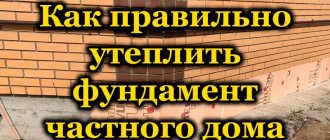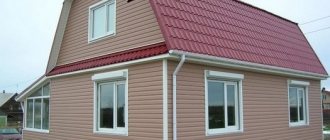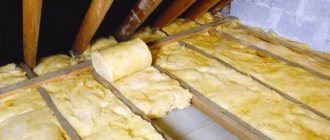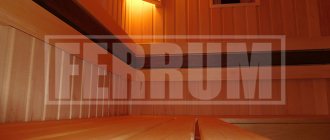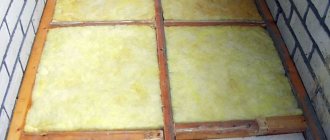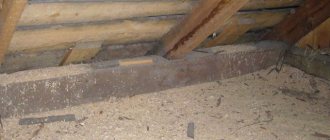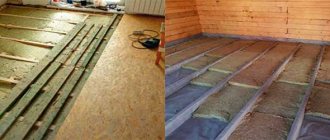Hot chocolate capsules Nescafe Dolce Gusto Chococino, 8 servings
334 ₽ More details
Nesquik Opti-Start instant cocoa drink, 250 g (package)
125 ₽ More details
Designer sconces
It's hard to be human | Haig Matt
389 ₽ More details
To my sisters. About those who will suffer | Nekrasova Evgenia Igorevna
452 ₽ More details
English language 9th grade tests
Warm floors in a living space mean comfort, coziness, and a healthy atmosphere. Modern buildings are designed using the latest technologies and are often equipped with heated technical rooms. The floor thermal insulation layer added during construction retains heat throughout the entire house and relieves owners from the hassle of additional floor insulation.
In private wooden buildings the situation is completely different. Outdated residential buildings often do not have an insulated floor above the cold basement. Often, owners carry out repair work themselves and insulate floors and ceilings in the basement with their own hands.
Why insulate the floor
In old wooden houses, cold cellars and vegetable storage facilities are always used. Such rooms, located below floor level, in most cases have a small thickness of the floor covering layer and cause a lot of trouble for the owners.
There are several ways to insulate a floor
Without an insulating layer, cold air and dampness come from under the floor all year round. This situation has a detrimental effect not only on human health - it affects the condition of the materials from which wooden floors and wooden floor boards are laid. Rotting processes also develop in wood.
It becomes noticeable that the wood is rotten, dilapidated, and on the log ceiling of the cellar you can see logs blackened by fungus. Until they finally turn into dust, the owner is faced with a completely solvable problem: how to replace the floors and what materials to use for this purpose.
Methods for laying insulation
Concrete floors can be insulated in three different ways:
- The simplest is to lay the insulation on a concrete surface in a continuous layer . To do this, the base is cleaned of dust, unevenness is eliminated, and, if necessary, filled with leveling mixtures. The insulation can be attached with glue, dowels, or a combined method, after which the finishing coating is installed. Individual insulation materials themselves act as finished floor coverings, which reduces installation time and saves a little money;
- frame method - logs are first installed on a concrete base, then the space between them is filled with insulation, and a finished floor is laid . The method is more labor-intensive, but allows the use of materials with a lower density that cannot withstand high loads;
- laying insulation under the screed - install a layer of thermal insulation on the concrete floor and fill it with cement-sand mortar on top , resulting in the formation of a solid solid base. The method is the most labor-intensive and time-consuming, but this base is perfect for any floor covering - from linoleum to tiles. In addition, this option is used when installing electric and water heated floors, which ensures uniform heat transfer over the entire area of the room.
Laying insulation on a concrete base
Insulation by joists
Insulation under the screed
When choosing, the determining criterion is the type of flooring and the method of its installation. For example, soft and rolled materials are not suitable for laying in a screed, since they are not intended for high loads. The same applies to insulation materials laid directly under the finishing coating: they must have good density and rigidity so as not to be pressed through during operation. It is also worth considering that logs and insulated screed take up to 15 cm in height, so for rooms with low ceilings the first installation method is preferable.
Methods for insulating the floor above the basement
To ensure that the basement does not cause trouble during further operation, the ceilings in the basement are replaced. Next, insulation work is carried out, and the choice of insulation, as well as insulation methods, is approached very thoroughly. The process includes not only insulating the ceiling and floor on the basement side, but also insulating the floor directly above the basement.
This is interesting: ways to insulate a basement ceiling from the inside.
In this video you will learn more about insulation: The process depends entirely on the design features of the building. A residential private house does not always have a basement. Insulation measures are carried out directly on the ground, since the thermal engineering calculation involves organizing a ceiling above the basement on the side of the house. During construction work, the quality and characteristics of the materials used should be taken into account.
Insulated with heating
Methods of insulation
Insulated with heating - this is the warmest floor, and therefore expensive and more difficult to make than a conventional insulated one. But there are also good sides: such a floor will be much better and more practical to use than a regular floor. For this floor you will need:
- ready-made cement;
- sand;
- plastic or metal pipes;
- fittings and bends;
- the floor covering you prefer.
What material is the floor insulated with?
The construction and installation of floor slabs is carried out in various ways, which, like the materials offered, are sufficient. It all depends on the features of the structure, individual requirements, owner preferences and financial capabilities. Many insulating raw materials have high-quality properties, good characteristics, and during operation receive only high marks.
Expanded polystyrene
Industrial enterprises produce several types of special slabs that can be used for insulation. When choosing a material, you must pay attention to the purpose of the room and the further load on the floor.
At the initial stage of the process, a thick layer of gravel is laid on the base of the prepared surface, which is covered with a concrete screed. Next, the floor is waterproofed. At the last stage, a wide, soft and comfortable roll of material is stretched.
Extruded polystyrene foam
These boards contain more durable materials. Construction raw materials have a high density and are used when it is necessary to support large weights and loads.
Expanded polystyrene practically does not absorb moisture; it is used in places even with high groundwater levels. The easy-to-use material is attractive due to its low price and does not require the help of special equipment during the work.
Polyurethane foam boards
Of the large number of tiled insulation materials offered, the best option is only rigid materials with a uniform structure and closed cells. They perform floor insulation with such building material more efficiently, in a short time and without extra costs.
Some types of insulation are covered with foil
Some types of polyurethane foam boards are covered with aluminum foil or fiberglass. Such additions increase thermal insulation properties, reduce moisture permeability and distinguish foam plastic from other similar materials.
Mineral wool
Rigid cotton wool boards are chosen as thermal insulation in a wooden house. The material is characterized by high resistance to deformation. You can install such an insulation system yourself, since the entire installation process will not take much time. The fibrous material absorbs moisture well; it is laid out over an unheated basement between two waterproofing layers. To insulate floors in residential premises, it is recommended to use ten-centimeter thick mineral wool.
Expanded clay
Bulk air material can replace three layers at once in insulating a home floor: concrete base, gravel, thermal insulation. Fill the drainage in layers, periodically compacting each layer. At the end, the expanded clay is poured with a solution of cement and sand. When the three-centimeter crust has hardened, waterproofing insulation and concrete screed are laid under the finished floor. After the insulation work has been completed, they begin laying the laminate.
Foam glass
Proper insulation with this material is carried out as follows:
- lay out a ten-centimeter gravel layer;
- pour concrete screed;
- a special adhesive composition is applied to the ends of the insulating blocks;
- After the glue has dried, the heated floor structure is installed.
In rooms with high humidity, to enhance waterproofing, roofing felt, two layers of polyethylene film, and a cement screed are laid over foam glass. Such actions are usually carried out if the final flooring is made of ceramic tiles.
Granulated slag
The material has high thermal insulation properties, but the by-product of iron smelting contains harmful impurities. In the construction and insulation of country houses, they use material that has undergone careful processing and has a document confirming compliance with regulatory requirements.
The slag is laid directly on leveled ground, without the use of waterproofing. The thickness of the layer should be 40 cm. Next, lay a layer of insulation. The poured concrete screed completes the process. The flooring can be laid out from any material you like.
Ecological wool
Fluff pulp is convenient in the work process. The environmentally friendly material is not damaged by rodents, insects, or fungi. When wet, it does not lose its protective properties, does not shrink, and when ignited, does not support the fire, but smolders. The material is used in dry form and with a solution.
This wool is easy to install
External insulation
If you are wondering how to insulate the basement from the outside, then pay attention to the insulation called polystyrene foam. He has proven himself very well. Slabs of various thicknesses are available for sale - from 50 to 100 mm, which will make it easy to achieve the desired level of frost protection.
In addition, insulating the basement floor with polystyrene foam has other advantages.
This material:
- has practically zero water absorption, which is a very significant factor for outdoor work;
- not subject to changes as a result of temperature changes;
- has high compressive strength;
- resistant to various bacteria, fungi and mold.
If we talk about the thermal insulation properties of the material, then a 50 mm thick slab can easily replace 12 cm thick brickwork in terms of insulation level. Expanded polystyrene slabs are perfectly cut and easy to install.
Using special glue, the material is laid on the surface of the walls, then fixed with special dowel nails. In addition, this material will level the surface of the plinth for further decorative finishing with stone or porcelain stoneware.
External insulation with penoplex
Technology for insulating the floor above the basement in a private house
The basement of a house can be used or not. It can be warm or cold. But regardless of the condition of the basement, the floors in the house must be warm. The work carried out on floor insulation in a private house has significant advantages:
- The consumption of heating media is reduced.
- A comfortable temperature regime is established in the room.
- Rotting and damage to floor structures does not begin between the slabs and the floor walls.
- There are no fungal deposits or mold on the foundation and walls.
- After the service life has expired, cosmetic finishing, repairs and arrangement do not take much time and money.
There are many technologies for insulating the floor above the basement, but the fastening methods for each material are different. When installing reliable thermal protection, it is necessary to observe the order of layers, which are the same for all existing methods. You should also take a responsible approach to the choice of materials and strictly follow all manufacturer’s recommendations.
Little subtleties when installing ventilation
You need to think about basement ventilation at the home design stage.
Ventilation holes, or vents, are made in the part of the foundation that rises above the ground. In a wooden house they are tightly closed for the winter.
Those owners who build their house themselves can equip the house with an additional ventilation hood leading to the roof. It is equipped with a damper. This hood will help ventilate the basement in the winter.
It should be noted that now there are devices that monitor the humidity in the basement and independently open the damper when the humidity levels reach a critical value. However, such devices are quite expensive. Therefore, in winter, you can simply manually open the damper for half an hour on those days when the temperature outside the house is above -15˚C. This will ensure preventative ventilation of the basement.
When installing ventilation, you need to consider the following points:
- the number of vents must be at least four;
- they should be located on opposite sides of the house, preferably on the south and north.
Usually the number of ventilation holes is even. This is due to the specifics of ventilation: one hole serves as a blower, and the other as an exhaust hood. That is, it blows into one and flies out of the other.
The main thing with ventilation is the temperature difference, which forces the air to circulate. It is for this reason that it is advisable to place vents on the southern and northern walls. For better air circulation, south-facing vents can be equipped with exhaust pipes with rain caps. Insulating the soil in the underground: it all depends on the wishes of the owners
Schemes for insulating the floor of the first floor on the ground and on the floor slab.
To properly insulate a basement, it is necessary to carry out thermal insulation and waterproofing of the soil. This is done in two ways:
- complex insulation, with the creation of a floor on the ground;
- The insulation is simple, with bulk insulation.
The first option allows you to then use the basement to store various items. If the plinth is of sufficient height, it can also serve as a utility room. It should be noted that the foundation must go deep from the floor line to a distance of at least 70-80 cm.
However, creating floors on the ground will require much more money and time than the second option. Therefore, if there is no urgent need, owners prefer to do only simple insulation of the subfloor in a wooden house.
Features of insulating the basement ceiling of an apartment building
All proposed methods and materials are relevant for basement floor insulation in private homes. In apartment buildings, owners of first-floor housing are often interested in how realistic it is to insulate the ceiling in the basement, when these premises are not personal property.
Living in an apartment with a basement underneath, residents are faced with the problem of cold floors, dampness and mold. Laying an insulating layer in an apartment causes high costs for insulation and forced replacement of the flooring. Also, this situation forces the owner to limit the thickness of the insulation layer if the apartment has low ceilings.
To carry out work on insulating the ceiling in the basement of an apartment building, residents will need a lot of effort, time, and patience to collect all kinds of permits and certificates. It is not a fact that the planned enterprise will be effective and positive.
Insulation in the basement
If possible, you can carry out additional insulation work on the basement side. It is produced on the ceiling surface of the basement. To do this, it is recommended to give preference to foam blocks, since this material copes well with high humidity. Foam blocks are glued to the ceiling surface using a specialized adhesive, which you can purchase at any hardware store.
After the adhesive has completely dried, the joints between the foam blocks will need to be sealed using polyurethane foam. Excess foam is removed with a knife.
It was not by chance that foam blocks were chosen as an example. Polystyrene foam is one of the cheapest materials for insulation. In addition, if it is damaged, replacement is quick and easy. However, the use of any other thermal insulation material is acceptable. This can be mineral wool, which is available in roll or slab form. The latter option is more convenient for fastening to the ceiling surface, since rolled mineral wool has a loose structure.
If you have a dry basement and floors made of reinforced concrete slabs, insulating material, presented in the form of a slab, will be the best solution. If the ceiling is made using wooden beams, it will be extremely difficult to fix the insulation in the form of sheets or slabs to the ceiling surface.
Since you will have to adjust and cut the insulation to avoid a gap at the joint. In this situation, it is recommended to give preference to roll insulation materials. Thanks to their flexible structure, they go around the beam and do not form a gap. The canvas is fixed with nails or self-tapping screws.
In order for any insulation material to efficiently cope with its functions, all joints formed between the vapor barrier film and the insulation must be sealed with construction tape. This will give a seal to the entire surface. To avoid the formation of condensation, under no circumstances should the ventilation hole be closed.
For more information on how to insulate the floor of the first floor from the basement side, see the following video.
Material selection
Without a doubt, it is best to insulate the cellar from the outside. But for many, this work seems impossible: you will have to dig up walls, dig huge pits to get to the walls, make sure that the dug holes do not damage the foundation of the building, etc. This work is labor-intensive, costly and not always doable with your own hands.
Polystyrene foam is an inexpensive and practical thermal insulation material.
You can insulate a cellar from the inside with almost any modern thermal insulation material. Builders recommend using the most common insulation - polystyrene foam. This material is durable, has a lot of positive properties and is well suited for insulating basement or cellar walls from the inside.
- does not collapse under the influence of water;
- not subject to biological effects;
- ease of installation in any quantities, ease of processing.
Among the disadvantages is the possibility of damage by rodents (mice easily chew through the foam layer). In addition, the material burns and supports combustion, but this disadvantage is not relevant for most cellars.
Polystyrene foam slabs do not collapse when exposed to moisture, but are resistant to rodents.
Thermal insulation of a house without heating
If the house is not heated, which is often the case in garden cooperatives, then there is often an opinion that protection of the foundation and soil is not needed due to the lack of people living in the house. This is a big mistake, since the design loses more than half of its service life in its reliability and service life.
Is it necessary to insulate the basement if there is no basement? The need for thermal insulation of a building becomes clear if we study the thermal contours of the structure:
- Geothermal heat is present in every area of the structure;
- Horizontal insulation retains the heat of the soil, preventing it from freezing;
- Vertical thermal insulation protects the structure and waterproofing layer from freezing during the cold season.
The horizontal contour made of polystyrene foam must be made monolithically, without joints or seams, therefore there are some features of laying slabs of the material:
- A thermal insulation layer is made under the base of the foundation along the entire perimeter of the pit and in part of the blind area, which will help retain heat under the entire house;
- Comprehensive protection against heat loss is done under the ground floor, the edges of the foundation from the inside, the outer sides of the foundation and under the blind area material to insulate the entire house and create a continuous line of the thermal contour.
If you do not thermally insulate the outer surfaces of a strip foundation with polystyrene foam, its destruction can occur even with high-quality waterproofing, well-equipped drainage systems, and when replacing the soil in the cavities with special materials.
Thermal insulation in houses with irregular heating
If the building is not used constantly, but is visited sporadically, then it is necessary, first of all, to heat the premises upon arrival. But when the owner leaves, the house cools down and does not heat up again until the next visit, thus, it can safely be classified as an unheated room, providing a thermal circuit using the technologies discussed above.
Insulated blind area
Reinforced concrete structures, which are massive, freeze much faster than their small counterparts. To do this, in any house without a basement you need to strengthen the thermal insulation in the corners. In this case, along the length of the polystyrene foam section in two layers, it is necessary to maintain a width of 3 times the size of the foundation tape, and the insulation placed according to the scheme must be placed on top of the first layer.
It is important to take into account that with pile and columnar foundations, a blind area is not needed in principle. All other options for the foundation of the house require its arrangement against heaving of the soil next to the base.
The given recommendations on how to insulate the basement of a house for buildings with different modes of use will help to significantly reduce the cost of operation and keep the building fit for habitation for a long time.
Insulation of the base from the inside
Quite often, those who are involved in building a house ask themselves why it is necessary to insulate the base from the inside if there is external insulation. There is no definite answer to this question, but if you want to ensure maximum heat conservation in your home, you should still do this.
The most commonly used materials for internal insulation are polystyrene foam, polystyrene foam and polyurethane foam. The latter option is the most preferable, since it allows you to obtain a monolithic thermal insulation layer, and the material itself has a long service life. The entry was published on March 25, 2016 by Anton in the Protection section.
What is this for?
First, to the question of whether it is necessary to insulate the base. In general, this is more of a rhetorical question.
The base is a continuation of the foundation, but it is visible above ground level. The element goes into the outer walls of the building and also acts as a support for them. So the base is a vulnerable element of the building.
Is it necessary and why to insulate the basement? Depending on the duration of frosts in winter, the foundation is actively affected by low temperatures. There is pressure from the hardened soil on the walls. This negatively affects the integrity of the structure. The cold penetrates more actively. Heat loss can be about 20%.
There are also water supply and sewerage systems running under the house. Once in the freezing zone, this can end unpleasantly.
But a base insulation unit is not always needed.
In fact, insulation of the ground under the house is not required if:
- in the region of residence, low sub-zero temperatures are rare;
- this is a country house where no one lives in winter;
- The basement is small and there is no basement.
Then you won’t have to worry about the foundation and heating of the building. There is no basement, winter is not cold.
But in all other situations, finishing the base with insulation is a prerequisite. The concrete slab will not cope with the loads. The wall may sag and become deformed. We don't need this. Especially when the basement floor is residential or is used frequently, and it is important to provide comfortable conditions there.
What insulation to use
In order for the waterproofing and insulation of the base to be successful, you need to decide on the choice of insulating material.
There are several options for how best to insulate the basement of a house from the outside.
To create a protective layer, you need to select a suitable material, as well as perform a calculation to determine the required amount of insulation.
The range of materials is extensive. But they are subject to the following requirements:
- low thermal conductivity;
- hydrophobicity;
- compressive strength (due to soil pressure);
- long service life;
- vapor permeable properties;
- resistance to fungus, mold and rodents.
When planning to insulate the basement of a house from the outside with polystyrene foam or other material, think in advance whether your choice is good.
Possible options
Let's go through the main options available.
- Mineral wool
. Quite often the basement is insulated with mineral wool. But it is only suitable for internal insulation due to water absorption. Requires mandatory waterproofing. Plus, cotton wool will not withstand soil pressure; - Styrofoam
. And its derivatives. At the price of quality, it is profitable to insulate a frame house or buildings made of other materials using polystyrene foam. Meets basic requirements. It is important to correctly calculate the thickness. Unfortunately, foam insulation is not as effective in some situations; - Polyurethane foam
. Applied by spraying. Fills small cracks and does not leave seams. In terms of water repellency, it is slightly inferior to foam plastic. Not afraid of mold and mildew. But it is not suitable for self-installation. Requires the participation of specialists. In general, liquid insulation is a new generation material; - Penofol
. Easy to install. Has decent characteristics. But it is not suitable as the main insulation material. Does not withstand loads and also has a soft structure; - Thermal panels
. Made from high rigidity polyurethane with overlays imitating different materials. They look nice and protect well. But the base must be perfectly flat; - Plaster
. Not a bad option. But rather for internal isolation. Absorbs water. Needs waterproofing. The plaster is heavy. A layer thicker than 5 cm cannot be made; - Soil
. Sand and earth are also used for insulation. Relevant if you have a minimum amount of money, or this is temporary housing. Thermal insulation properties are low; - Expanded clay
. Granulated clay. Safe, environmentally friendly, lightweight and affordable. But the structure is porous, which allows water to pass through. Suitable for a summer house where people do not live all year round.
There are such options. All you have to do is decide what's right for your situation.
Main types of heat-insulating materials
The main types of heat-insulating materials are:
- polymer materials;
- fibrous materials.
Polymer materials
Polymer materials include polystyrene foam, polystyrene foam, penoplex and polyurethane foam.
The most suitable insulation is certainly sprayed polyurethane foam. It will perfectly fill all the cracks, in addition, it will not require additional hydro and vapor barrier. All that remains is to make a false wall on top of it and the work is completed.
When using polystyrene foam, penoplex or expanded polystyrene, you must first apply a waterproofing layer to the wall. This can be liquid rubber, tar, or waterproofing films.
On top of it, using special glue and dowels with fungi, sheets of insulation are tightly attached to each other. The gaps between the sheets are sealed with foam or sealant, in the case of expanded polystyrene. The thickness of the insulation layer is usually 10 cm, but it all depends on the specific situation.
After this, the outer side of the insulation is covered with an adhesive composition, onto which a reinforcing mesh is applied. Another layer of glue is applied to the mesh. After all layers have dried, you can begin finishing - grouting, priming and plastering.
Important: when insulating basement walls, it is not recommended to use polystyrene foam. But if you still choose it, you need to choose the most moisture-resistant and durable, for example, PSB-S-15 brand
Mineral wool and other types of fibrous materials
These types of insulation are categorically not recommended for insulating any premises from the inside. Due to the fact that the dew point when insulating from the inside is located on the inner surface of the wall, it will constantly condense moisture.
When moisture gets on any materials that have fibers in their structure, they lose their heat-insulating properties, and the entire insulation procedure becomes meaningless.
If you still have to insulate the basement with such materials, you must carefully protect them from the wall. This can be a double layer of waterproofing, or an air gap.
After installing the mineral wool, be sure to use a layer of vapor barrier so that the wool “breathes.” Then again there is an air gap and only then finishing with plasterboard or wooden panels.
